Abstract
This article addresses the evidence that trichloroethylene (TCE) or its metabolites might mediate tumor formation via a mutagenic mode of action. We review and draw conclusions from the published mutagenicity and genotoxicity information for TCE and its metabolites, chloral hydrate (CH), dichloroacetic acid (DCA), trichloroacetic acid (TCA), trichloroethanol, S-(1, 2-dichlorovinyl)-l-cysteine (DCVC), and S-(1, 2-dichlorovinyl) glutathione (DCVG). The new U.S. Environmental Protection Agency proposed Cancer Risk Assessment Guidelines provide for an assessment of the key events involved in the development of specific tumors. Consistent with this thinking, we provide a new and general strategy for interpreting genotoxicity data that goes beyond a simple determination that the chemical is or is not genotoxic. For TCE, we conclude that the weight of the evidence argues that chemically induced mutation is unlikely to be a key event in the induction of human tumors that might be caused by TCE itself (as the parent compound) and its metabolites, CH, DCA, and TCA. This conclusion derives primarily from the fact that these chemicals require very high doses to be genotoxic. There is not enough information to draw any conclusions for trichloroethanol and the two trichloroethylene conjugates, DCVC and DCVG. There is some evidence that DCVC is a more potent mutagen than CH, DCA, or TCA. Unfortunately, definitive conclusions as to whether TCE will induce tumors in humans via a mutagenic mode of action cannot be drawn from the available information. More research, including the development and use of new techniques, is required before it is possible to make a definitive assessment as to whether chemically induced mutation is a key event in any human tumors resulting from exposure to TCE.
Full text
PDF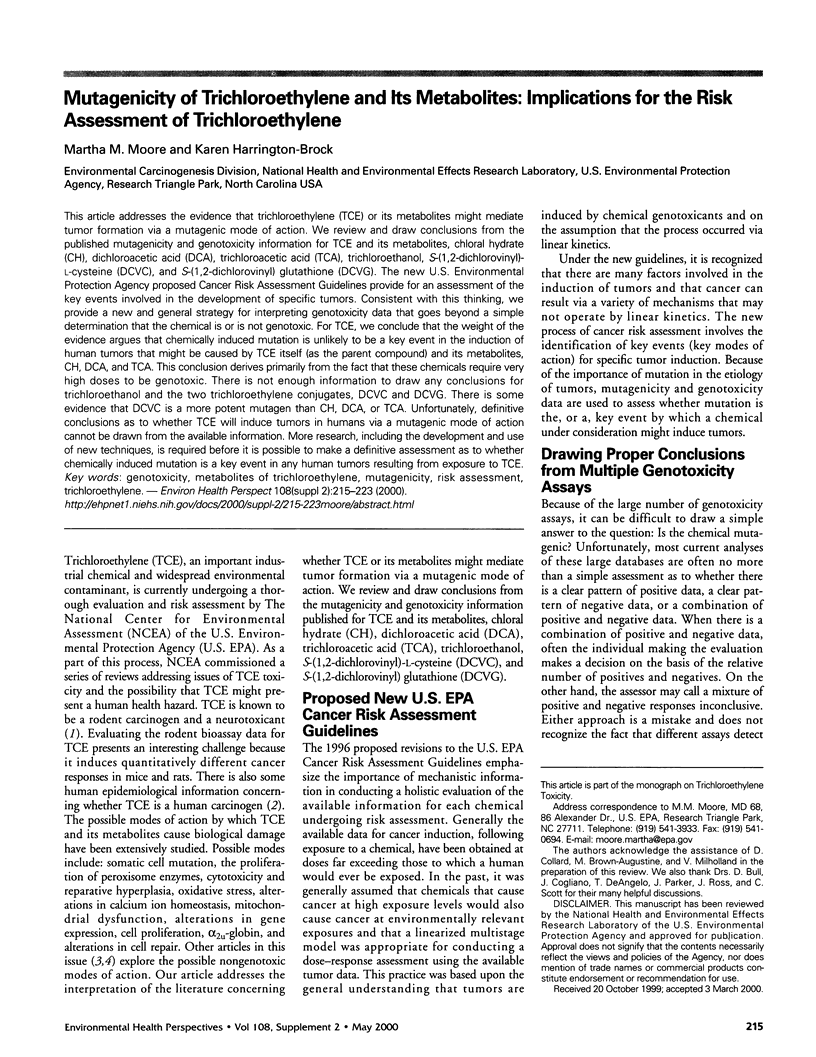
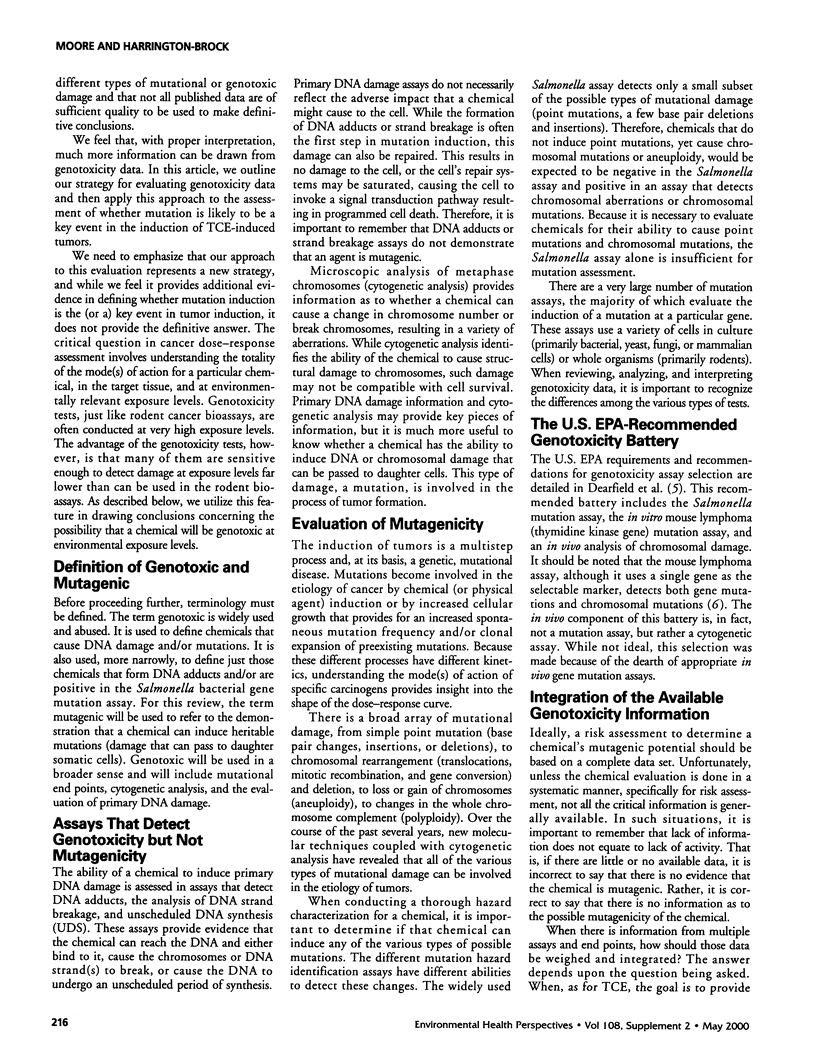
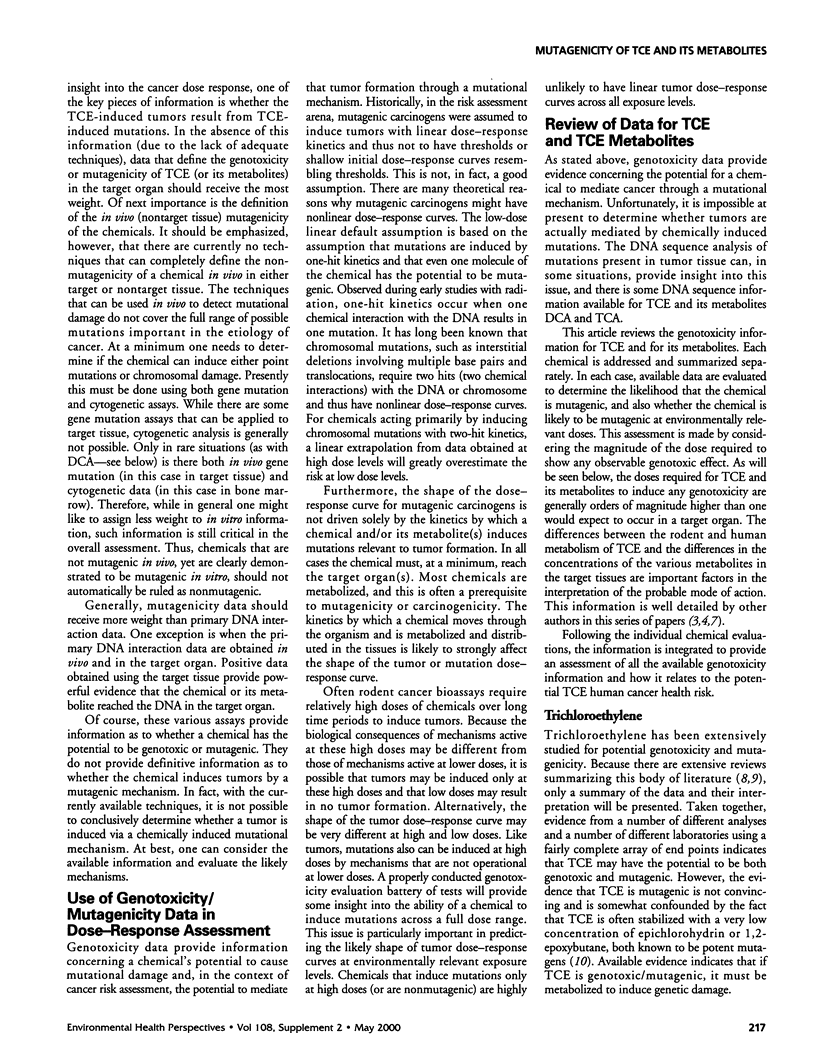
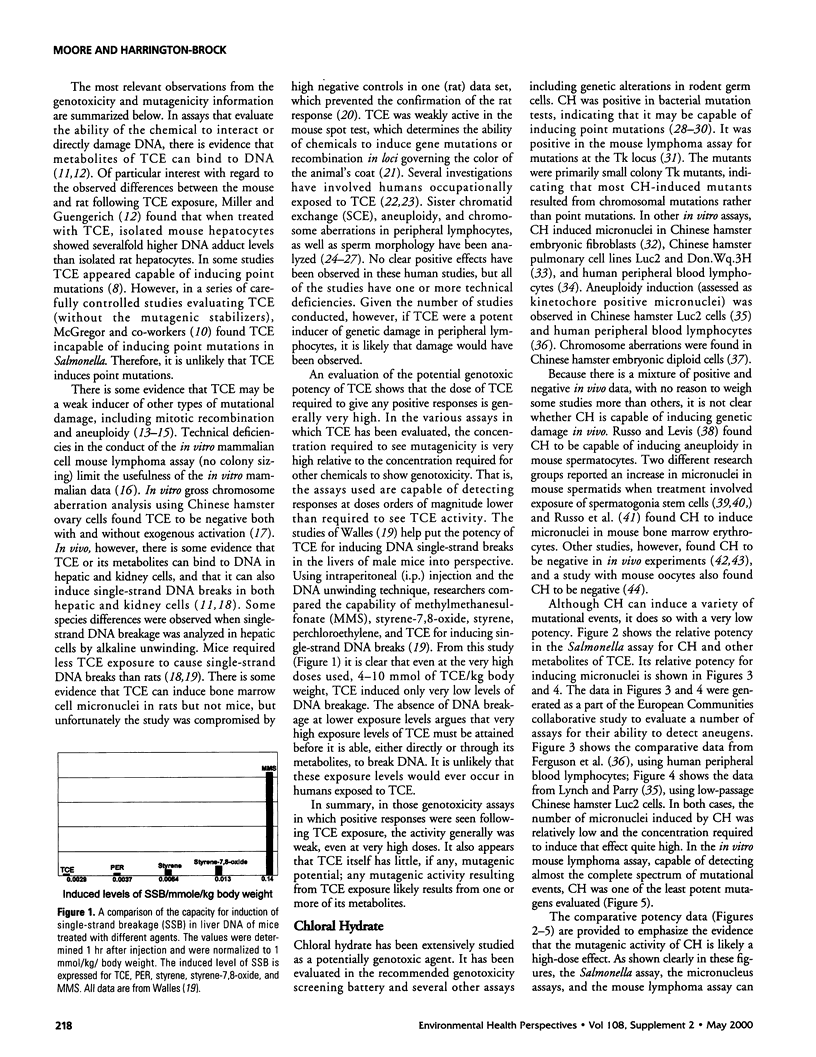
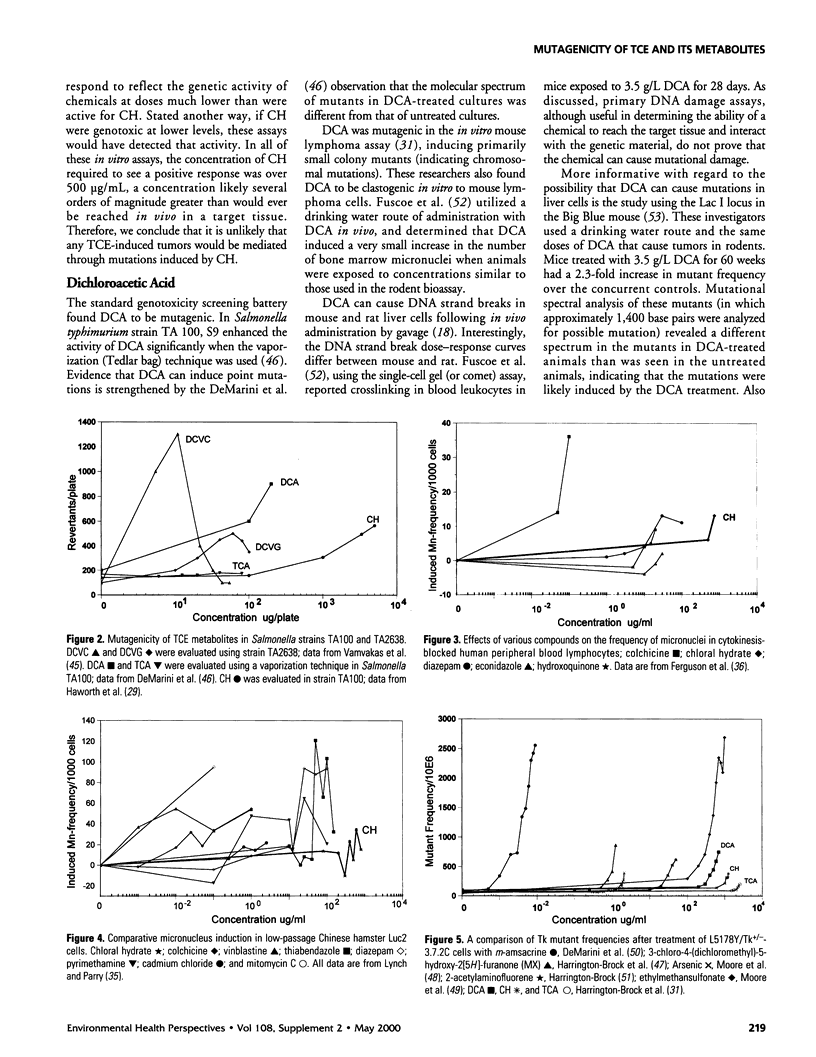
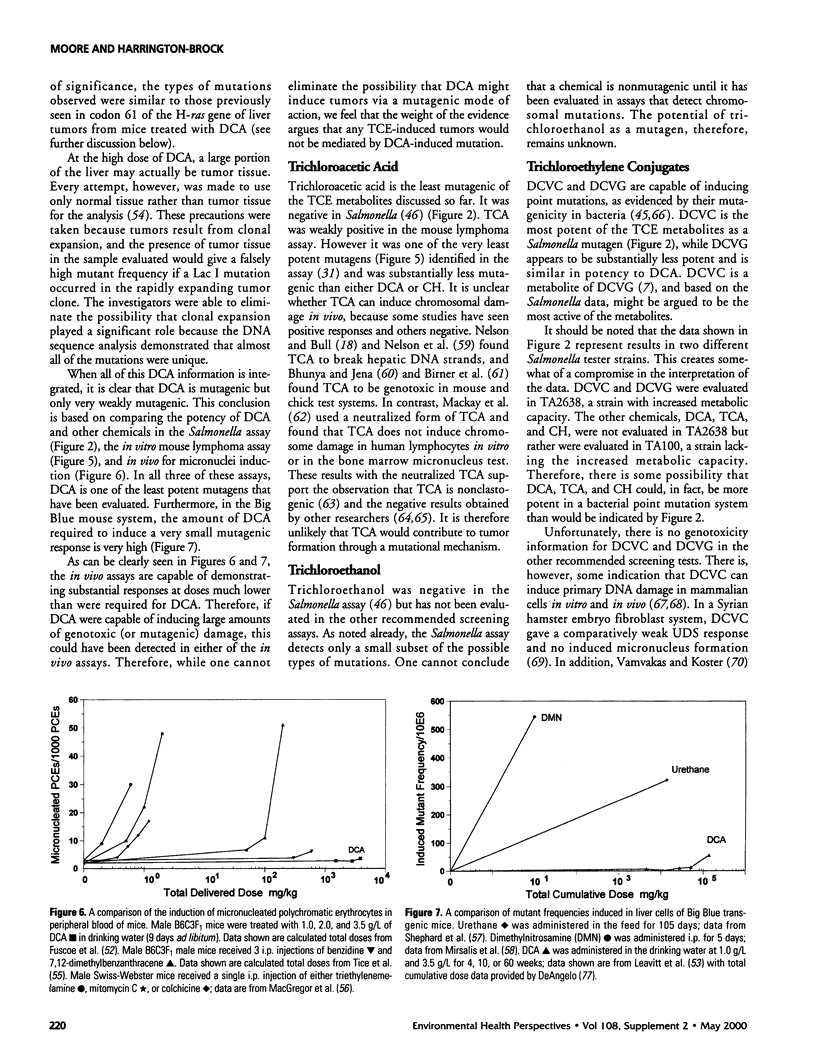
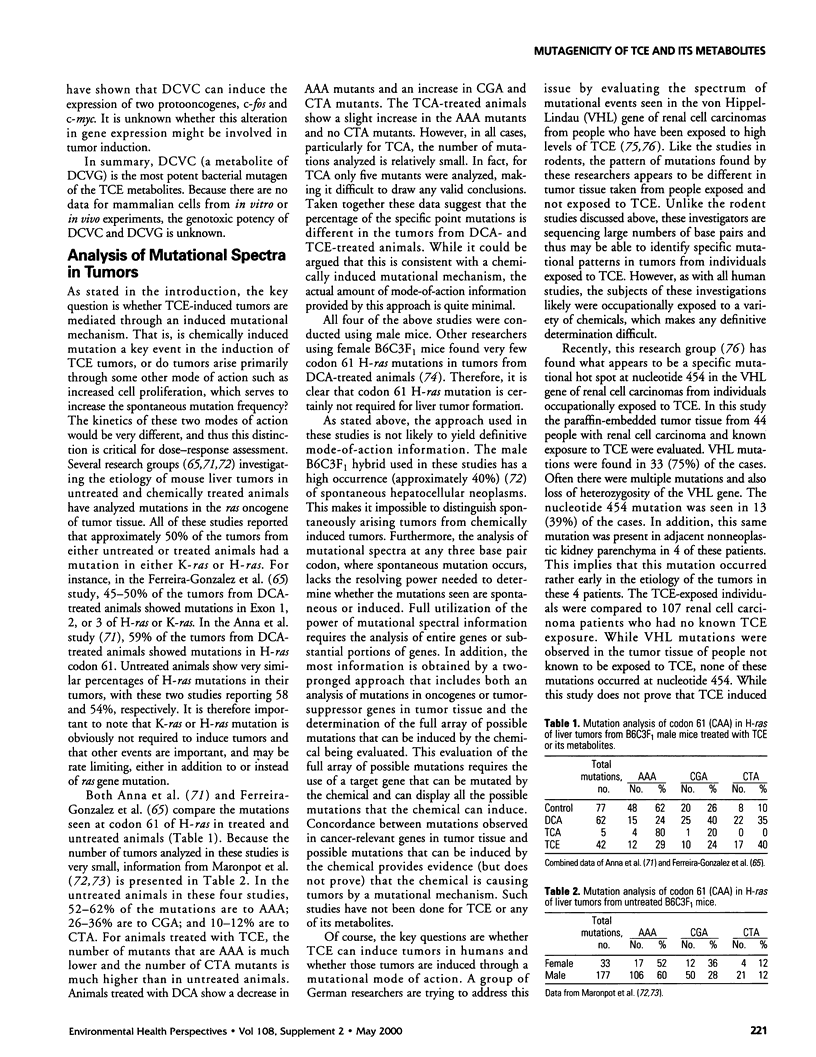
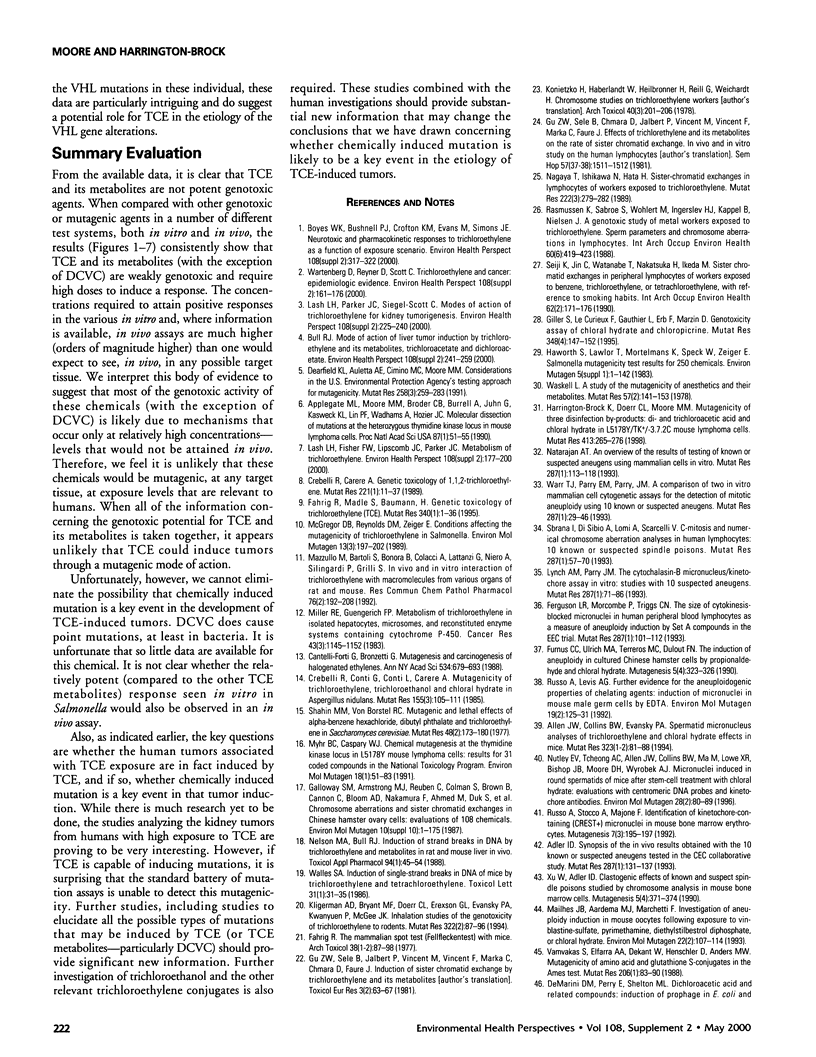
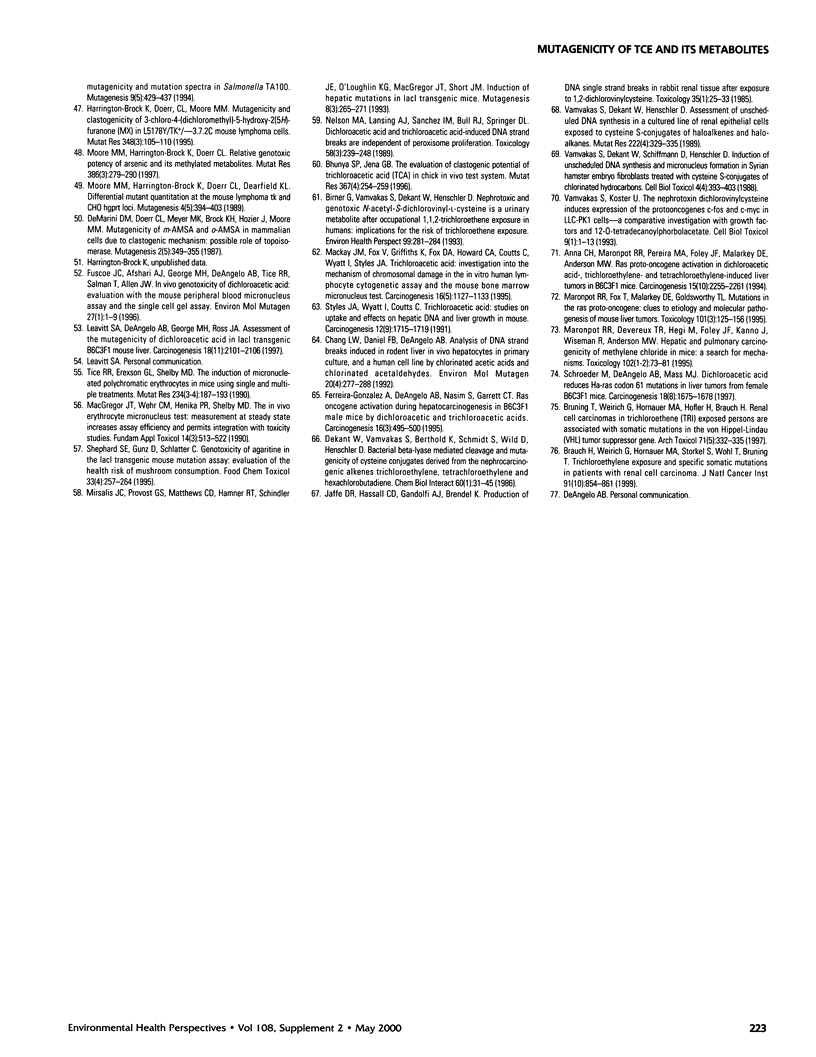
Selected References
These references are in PubMed. This may not be the complete list of references from this article.
- Adler I. D. Synopsis of the in vivo results obtained with the 10 known or suspected aneugens tested in the CEC collaborative study. Mutat Res. 1993 May;287(1):131–137. doi: 10.1016/0027-5107(93)90152-6. [DOI] [PubMed] [Google Scholar]
- Allen J. W., Collins B. W., Evansky P. A. Spermatid micronucleus analyses of trichloroethylene and chloral hydrate effects in mice. Mutat Res. 1994 Jan-Feb;323(1-2):81–88. doi: 10.1016/0165-7992(94)90049-3. [DOI] [PubMed] [Google Scholar]
- Anna C. H., Maronpot R. R., Pereira M. A., Foley J. F., Malarkey D. E., Anderson M. W. ras proto-oncogene activation in dichloroacetic acid-, trichloroethylene- and tetrachloroethylene-induced liver tumors in B6C3F1 mice. Carcinogenesis. 1994 Oct;15(10):2255–2261. doi: 10.1093/carcin/15.10.2255. [DOI] [PubMed] [Google Scholar]
- Applegate M. L., Moore M. M., Broder C. B., Burrell A., Juhn G., Kasweck K. L., Lin P. F., Wadhams A., Hozier J. C. Molecular dissection of mutations at the heterozygous thymidine kinase locus in mouse lymphoma cells. Proc Natl Acad Sci U S A. 1990 Jan;87(1):51–55. doi: 10.1073/pnas.87.1.51. [DOI] [PMC free article] [PubMed] [Google Scholar]
- Bhunya S. P., Jena G. B. The evaluation of clastogenic potential of trichloroacetic acid (TCA) in chick in vivo test system. Mutat Res. 1996 Apr 6;367(4):254–259. [PubMed] [Google Scholar]
- Birner G., Vamvakas S., Dekant W., Henschler D. Nephrotoxic and genotoxic N-acetyl-S-dichlorovinyl-L-cysteine is a urinary metabolite after occupational 1,1,2-trichloroethene exposure in humans: implications for the risk of trichloroethene exposure. Environ Health Perspect. 1993 Mar;99:281–284. doi: 10.1289/ehp.9399281. [DOI] [PMC free article] [PubMed] [Google Scholar]
- Boyes W. K., Bushnell P. J., Crofton K. M., Evans M., Simmons J. E. Neurotoxic and pharmacokinetic responses to trichloroethylene as a function of exposure scenario. Environ Health Perspect. 2000 May;108 (Suppl 2):317–322. doi: 10.1289/ehp.00108s2317. [DOI] [PMC free article] [PubMed] [Google Scholar]
- Brauch H., Weirich G., Hornauer M. A., Störkel S., Wöhl T., Brüning T. Trichloroethylene exposure and specific somatic mutations in patients with renal cell carcinoma. J Natl Cancer Inst. 1999 May 19;91(10):854–861. doi: 10.1093/jnci/91.10.854. [DOI] [PubMed] [Google Scholar]
- Brüning T., Weirich G., Hornauer M. A., Höfler H., Brauch H. Renal cell carcinomas in trichloroethene (TRI) exposed persons are associated with somatic mutations in the von Hippel-Lindau (VHL) tumour suppressor gene. Arch Toxicol. 1997;71(5):332–335. doi: 10.1007/s002040050394. [DOI] [PubMed] [Google Scholar]
- Bull R. J. Mode of action of liver tumor induction by trichloroethylene and its metabolites, trichloroacetate and dichloroacetate. Environ Health Perspect. 2000 May;108 (Suppl 2):241–259. doi: 10.1289/ehp.00108s2241. [DOI] [PMC free article] [PubMed] [Google Scholar]
- Cantelli-Forti G., Bronzetti G. Mutagenesis and carcinogenesis of halogenated ethylenes. Ann N Y Acad Sci. 1988;534:679–693. doi: 10.1111/j.1749-6632.1988.tb30158.x. [DOI] [PubMed] [Google Scholar]
- Chang L. W., Daniel F. B., DeAngelo A. B. Analysis of DNA strand breaks induced in rodent liver in vivo, hepatocytes in primary culture, and a human cell line by chlorinated acetic acids and chlorinated acetaldehydes. Environ Mol Mutagen. 1992;20(4):277–288. doi: 10.1002/em.2850200406. [DOI] [PubMed] [Google Scholar]
- Crebelli R., Carere A. Genetic toxicology of 1,1,2-trichloroethylene. Mutat Res. 1989 Jul;221(1):11–37. doi: 10.1016/0165-1110(89)90043-2. [DOI] [PubMed] [Google Scholar]
- DeMarini D. M., Doerr C. L., Meyer M. K., Brock K. H., Hozier J., Moore M. M. Mutagenicity of m-AMSA and o-AMSA in mammalian cells due to clastogenic mechanism: possible role of topoisomerase. Mutagenesis. 1987 Sep;2(5):349–355. doi: 10.1093/mutage/2.5.349. [DOI] [PubMed] [Google Scholar]
- Dearfield K. L., Auletta A. E., Cimino M. C., Moore M. M. Considerations in the U.S. Environmental Protection Agency's testing approach for mutagenicity. Mutat Res. 1991 Nov;258(3):259–283. doi: 10.1016/0165-1110(91)90012-k. [DOI] [PubMed] [Google Scholar]
- Dekant W., Vamvakas S., Berthold K., Schmidt S., Wild D., Henschler D. Bacterial beta-lyase mediated cleavage and mutagenicity of cysteine conjugates derived from the nephrocarcinogenic alkenes trichloroethylene, tetrachloroethylene and hexachlorobutadiene. Chem Biol Interact. 1986 Oct 15;60(1):31–45. doi: 10.1016/0009-2797(86)90015-3. [DOI] [PubMed] [Google Scholar]
- Fahrig R., Madle S., Baumann H. Genetic toxicology of trichloroethylene (TCE). Mutat Res. 1995 Nov;340(1):1–36. doi: 10.1016/0165-1110(95)90002-0. [DOI] [PubMed] [Google Scholar]
- Fahrig R. The mammalian spot test (Fellfleckentest) with mice. Arch Toxicol. 1977 Sep 21;38(1-2):87–98. doi: 10.1007/BF00293666. [DOI] [PubMed] [Google Scholar]
- Ferguson L. R., Morcombe P., Triggs C. N. The size of cytokinesis-blocked micronuclei in human peripheral blood lymphocytes as a measure of aneuploidy induction by Set A compounds in the EEC trial. Mutat Res. 1993 May;287(1):101–112. doi: 10.1016/0027-5107(93)90149-a. [DOI] [PubMed] [Google Scholar]
- Ferreira-Gonzalez A., DeAngelo A. B., Nasim S., Garrett C. T. Ras oncogene activation during hepatocarcinogenesis in B6C3F1 male mice by dichloroacetic and trichloroacetic acids. Carcinogenesis. 1995 Mar;16(3):495–500. doi: 10.1093/carcin/16.3.495. [DOI] [PubMed] [Google Scholar]
- Furnus C. C., Ulrich M. A., Terreros M. C., Dulout F. N. The induction of aneuploidy in cultured Chinese hamster cells by propionaldehyde and chloral hydrate. Mutagenesis. 1990 Jul;5(4):323–326. doi: 10.1093/mutage/5.4.323. [DOI] [PubMed] [Google Scholar]
- Fuscoe J. C., Afshari A. J., George M. H., DeAngelo A. B., Tice R. R., Salman T., Allen J. W. In vivo genotoxicity of dichloroacetic acid: evaluation with the mouse peripheral blood micronucleus assay and the single cell gel assay. Environ Mol Mutagen. 1996;27(1):1–9. doi: 10.1002/(SICI)1098-2280(1996)27:1<1::AID-EM1>3.0.CO;2-L. [DOI] [PubMed] [Google Scholar]
- Galloway S. M., Armstrong M. J., Reuben C., Colman S., Brown B., Cannon C., Bloom A. D., Nakamura F., Ahmed M., Duk S. Chromosome aberrations and sister chromatid exchanges in Chinese hamster ovary cells: evaluations of 108 chemicals. Environ Mol Mutagen. 1987;10 (Suppl 10):1–175. doi: 10.1002/em.2850100502. [DOI] [PubMed] [Google Scholar]
- Giller S., Le Curieux F., Gauthier L., Erb F., Marzin D. Genotoxicity assay of chloral hydrate and chloropicrine. Mutat Res. 1995 Dec;348(4):147–152. doi: 10.1016/0165-7992(95)90002-0. [DOI] [PubMed] [Google Scholar]
- Gu Z. W., Sele B., Chmara D., Jalbert P., Vincent M., Vincent F., Marka C., Faure J. Effets du trichloréthylène et de ses métabolites sur le taux d' échanges de chromatides-sceurs. Etude in vivo et in vitro sur les lymphocytes humains. Sem Hop. 1981 Oct 8;57(37-38):1511–1512. [PubMed] [Google Scholar]
- Gu Z. W., Sele B., Jalbert P., Vincent M., Vincent F., Marka C., Chmara D., Faure J. Induction d'échanges entre les chromatides soeurs (SCE) par le trichloréthylène et ses métabolites. Toxicol Eur Res. 1981 Mar;3(2):63–67. [PubMed] [Google Scholar]
- Harrington-Brock K., Doerr C. L., Moore M. M. Mutagenicity and clastogenicity of 3-chloro-4-(dichloromethyl)-5-hydroxy-2(5H)-furanone (MX) in L5178Y/TK+/(-)-3.7.2C mouse lymphoma cells. Mutat Res. 1995 Nov;348(3):105–110. doi: 10.1016/0165-7992(95)00052-6. [DOI] [PubMed] [Google Scholar]
- Harrington-Brock K., Doerr C. L., Moore M. M. Mutagenicity of three disinfection by-products: di- and trichloroacetic acid and chloral hydrate in L5178Y/TK +/- (-)3.7.2C mouse lymphoma cells. Mutat Res. 1998 Mar 30;413(3):265–276. doi: 10.1016/s1383-5718(98)00026-6. [DOI] [PubMed] [Google Scholar]
- Haworth S., Lawlor T., Mortelmans K., Speck W., Zeiger E. Salmonella mutagenicity test results for 250 chemicals. Environ Mutagen. 1983;5 (Suppl 1):1–142. [PubMed] [Google Scholar]
- Jaffe D. R., Hassall C. D., Gandolfi A. J., Brendel K. Production of DNA single strand breaks in rabbit renal tissue after exposure to 1,2-dichlorovinylcysteine. Toxicology. 1985 Apr;35(1):25–33. doi: 10.1016/0300-483x(85)90129-5. [DOI] [PubMed] [Google Scholar]
- Kligerman A. D., Bryant M. F., Doerr C. L., Erexson G. L., Evansky P. A., Kwanyuen P., McGee J. K. Inhalation studies of the genotoxicity of trichloroethylene to rodents. Mutat Res. 1994 Aug;322(2):87–96. doi: 10.1016/0165-1218(94)00013-1. [DOI] [PubMed] [Google Scholar]
- Lash L. H., Fisher J. W., Lipscomb J. C., Parker J. C. Metabolism of trichloroethylene. Environ Health Perspect. 2000 May;108 (Suppl 2):177–200. doi: 10.1289/ehp.00108s2177. [DOI] [PMC free article] [PubMed] [Google Scholar]
- Lash L. H., Parker J. C., Scott C. S. Modes of action of trichloroethylene for kidney tumorigenesis. Environ Health Perspect. 2000 May;108 (Suppl 2):225–240. doi: 10.1289/ehp.00108s2225. [DOI] [PMC free article] [PubMed] [Google Scholar]
- Leavitt S. A., DeAngelo A. B., George M. H., Ross J. A. Assessment of the mutagenicity of dichloroacetic acid in lacI transgenic B6C3F1 mouse liver. Carcinogenesis. 1997 Nov;18(11):2101–2106. doi: 10.1093/carcin/18.11.2101. [DOI] [PubMed] [Google Scholar]
- Lynch A. M., Parry J. M. The cytochalasin-B micronucleus/kinetochore assay in vitro: studies with 10 suspected aneugens. Mutat Res. 1993 May;287(1):71–86. doi: 10.1016/0027-5107(93)90146-7. [DOI] [PubMed] [Google Scholar]
- MacGregor J. T., Wehr C. M., Henika P. R., Shelby M. D. The in vivo erythrocyte micronucleus test: measurement at steady state increases assay efficiency and permits integration with toxicity studies. Fundam Appl Toxicol. 1990 Apr;14(3):513–522. doi: 10.1016/0272-0590(90)90255-i. [DOI] [PubMed] [Google Scholar]
- Mackay J. M., Fox V., Griffiths K., Fox D. A., Howard C. A., Coutts C., Wyatt I., Styles J. A. Trichloroacetic acid: investigation into the mechanism of chromosomal damage in the in vitro human lymphocyte cytogenetic assay and the mouse bone marrow micronucleus test. Carcinogenesis. 1995 May;16(5):1127–1133. doi: 10.1093/carcin/16.5.1127. [DOI] [PubMed] [Google Scholar]
- Mailhes J. B., Aardema M. J., Marchetti F. Investigation of aneuploidy induction in mouse oocytes following exposure to vinblastine-sulfate, pyrimethamine, diethylstilbestrol diphosphate, or chloral hydrate. Environ Mol Mutagen. 1993;22(2):107–114. doi: 10.1002/em.2850220209. [DOI] [PubMed] [Google Scholar]
- Maronpot R. R., Devereux T. R., Hegi M., Foley J. F., Kanno J., Wiseman R., Anderson M. W. Hepatic and pulmonary carcinogenicity of methylene chloride in mice: a search for mechanisms. Toxicology. 1995 Sep 1;102(1-2):73–81. doi: 10.1016/0300-483x(95)03037-g. [DOI] [PubMed] [Google Scholar]
- Maronpot R. R., Fox T., Malarkey D. E., Goldsworthy T. L. Mutations in the ras proto-oncogene: clues to etiology and molecular pathogenesis of mouse liver tumors. Toxicology. 1995 Aug 25;101(3):125–156. doi: 10.1016/0300-483x(95)03112-s. [DOI] [PubMed] [Google Scholar]
- Mazzullo M., Bartoli S., Bonora B., Colacci A., Lattanzi G., Niero A., Silingardi P., Grilli S. In vivo and in vitro interaction of trichloroethylene with macromolecules from various organs of rat and mouse. Res Commun Chem Pathol Pharmacol. 1992 May;76(2):192–208. [PubMed] [Google Scholar]
- McGregor D. B., Reynolds D. M., Zeiger E. Conditions affecting the mutagenicity of trichloroethylene in Salmonella. Environ Mol Mutagen. 1989;13(3):197–202. doi: 10.1002/em.2850130302. [DOI] [PubMed] [Google Scholar]
- Mirsalis J. C., Provost G. S., Matthews C. D., Hamner R. T., Schindler J. E., O'Loughlin K. G., MacGregor J. T., Short J. M. Induction of hepatic mutations in lacI transgenic mice. Mutagenesis. 1993 May;8(3):265–271. doi: 10.1093/mutage/8.3.265. [DOI] [PubMed] [Google Scholar]
- Moore M. M., Harrington-Brock K., Doerr C. L., Dearfield K. L. Differential mutant quantitation at the mouse lymphoma tk and CHO hgprt loci. Mutagenesis. 1989 Sep;4(5):394–403. doi: 10.1093/mutage/4.5.394. [DOI] [PubMed] [Google Scholar]
- Moore M. M., Harrington-Brock K., Doerr C. L. Relative genotoxic potency of arsenic and its methylated metabolites. Mutat Res. 1997 Jun;386(3):279–290. doi: 10.1016/s1383-5742(97)00003-3. [DOI] [PubMed] [Google Scholar]
- Myhr B. C., Caspary W. J. Chemical mutagenesis at the thymidine kinase locus in L5178Y mouse lymphoma cells: results for 31 coded compounds in the National Toxicology Program. Environ Mol Mutagen. 1991;18(1):51–83. doi: 10.1002/em.2850180109. [DOI] [PubMed] [Google Scholar]
- Nagaya T., Ishikawa N., Hata H. Sister-chromatid exchanges in lymphocytes of workers exposed to trichloroethylene. Mutat Res. 1989 Mar;222(3):279–282. doi: 10.1016/0165-1218(89)90144-4. [DOI] [PubMed] [Google Scholar]
- Natarajan A. T. An overview of the results of testing of known or suspected aneugens using mammalian cells in vitro. Mutat Res. 1993 May;287(1):113–118. doi: 10.1016/0027-5107(93)90150-e. [DOI] [PubMed] [Google Scholar]
- Nelson M. A., Bull R. J. Induction of strand breaks in DNA by trichloroethylene and metabolites in rat and mouse liver in vivo. Toxicol Appl Pharmacol. 1988 Jun 15;94(1):45–54. doi: 10.1016/0041-008x(88)90335-3. [DOI] [PubMed] [Google Scholar]
- Nelson M. A., Lansing A. J., Sanchez I. M., Bull R. J., Springer D. L. Dichloroacetic acid and trichloroacetic acid-induced DNA strand breaks are independent of peroxisome proliferation. Toxicology. 1989 Oct 16;58(3):239–248. doi: 10.1016/0300-483x(89)90139-x. [DOI] [PubMed] [Google Scholar]
- Nutley E. V., Tcheong A. C., Allen J. W., Collins B. W., Ma M., Lowe X. R., Bishop J. B., Moore D. H., 2nd, Wyrobek A. J. Micronuclei induced in round spermatids of mice after stem-cell treatment with chloral hydrate: evaluations with centromeric DNA probes and kinetochore antibodies. Environ Mol Mutagen. 1996;28(2):80–89. doi: 10.1002/(SICI)1098-2280(1996)28:2<80::AID-EM3>3.0.CO;2-I. [DOI] [PubMed] [Google Scholar]
- Rasmussen K., Sabroe S., Wohlert M., Ingerslev H. J., Kappel B., Nielsen J. A genotoxic study of metal workers exposed to trichloroethylene. Sperm parameters and chromosome aberrations in lymphocytes. Int Arch Occup Environ Health. 1988;60(6):419–423. doi: 10.1007/BF00381389. [DOI] [PubMed] [Google Scholar]
- Russo A., Stocco A., Majone F. Identification of kinetochore-containing (CREST+) micronuclei in mouse bone marrow erythrocytes. Mutagenesis. 1992 May;7(3):195–197. doi: 10.1093/mutage/7.3.195. [DOI] [PubMed] [Google Scholar]
- Sbrana I., Di Sibio A., Lomi A., Scarcelli V. C-mitosis and numerical chromosome aberration analyses in human lymphocytes: 10 known or suspected spindle poisons. Mutat Res. 1993 May;287(1):57–70. doi: 10.1016/0027-5107(93)90145-6. [DOI] [PubMed] [Google Scholar]
- Schroeder M., DeAngelo A. B., Mass M. J. Dichloroacetic acid reduces Ha-ras codon 61 mutations in liver tumors from female B6C3F1 mice. Carcinogenesis. 1997 Aug;18(8):1675–1678. doi: 10.1093/carcin/18.8.1675. [DOI] [PubMed] [Google Scholar]
- Seiji K., Jin C., Watanabe T., Nakatsuka H., Ikeda M. Sister chromatid exchanges in peripheral lymphocytes of workers exposed to benzene, trichloroethylene, or tetrachloroethylene, with reference to smoking habits. Int Arch Occup Environ Health. 1990;62(2):171–176. doi: 10.1007/BF00383594. [DOI] [PubMed] [Google Scholar]
- Shahin M. M., Von Borstel R. C. Mutagenic and lethal effects of alpha-benzene hexachloride, dibutyl phthalate and trichloroethylene in Saccharomyces cerevisiae. Mutat Res. 1977 Apr;48(2):173–180. doi: 10.1016/0027-5107(77)90157-9. [DOI] [PubMed] [Google Scholar]
- Shephard S. E., Gunz D., Schlatter C. Genotoxicity of agaritine in the lacI transgenic mouse mutation assay: evaluation of the health risk of mushroom consumption. Food Chem Toxicol. 1995 Apr;33(4):257–264. doi: 10.1016/0278-6915(94)00142-b. [DOI] [PubMed] [Google Scholar]
- Styles J. A., Wyatt I., Coutts C. Trichloroacetic acid: studies on uptake and effects on hepatic DNA and liver growth in mouse. Carcinogenesis. 1991 Sep;12(9):1715–1719. doi: 10.1093/carcin/12.9.1715. [DOI] [PubMed] [Google Scholar]
- Tice R. R., Erexson G. L., Shelby M. D. The induction of micronucleated polychromatic erythrocytes in mice using single and multiple treatments. Mutat Res. 1990 Jun-Aug;234(3-4):187–193. doi: 10.1016/0165-1161(90)90014-f. [DOI] [PubMed] [Google Scholar]
- Vamvakas S., Dekant W., Henschler D. Assessment of unscheduled DNA synthesis in a cultured line of renal epithelial cells exposed to cysteine S-conjugates of haloalkenes and haloalkanes. Mutat Res. 1989 Apr;222(4):329–335. doi: 10.1016/0165-1218(89)90108-0. [DOI] [PubMed] [Google Scholar]
- Vamvakas S., Dekant W., Schiffmann D., Henschler D. Induction of unscheduled DNA synthesis and micronucleus formation in Syrian hamster embryo fibroblasts treated with cysteine S-conjugates of chlorinated hydrocarbons. Cell Biol Toxicol. 1988 Dec;4(4):393–403. doi: 10.1007/BF00117768. [DOI] [PubMed] [Google Scholar]
- Vamvakas S., Elfarra A. A., Dekant W., Henschler D., Anders M. W. Mutagenicity of amino acid and glutathione S-conjugates in the Ames test. Mutat Res. 1988 Sep;206(1):83–90. doi: 10.1016/0165-1218(88)90144-9. [DOI] [PubMed] [Google Scholar]
- Vamvakas S., Köster U. The nephrotoxin dichlorovinylcysteine induces expression of the protooncogenes c-fos and c-myc in LLC-PK1 cells--a comparative investigation with growth factors and 12-O-tetradecanoylphorbolacetate. Cell Biol Toxicol. 1993 Jan-Mar;9(1):1–13. doi: 10.1007/BF00755136. [DOI] [PubMed] [Google Scholar]
- Walles S. A. Induction of single-strand breaks in DNA of mice by trichloroethylene and tetrachloroethylene. Toxicol Lett. 1986 Apr;31(1):31–35. doi: 10.1016/0378-4274(86)90191-8. [DOI] [PubMed] [Google Scholar]
- Warr T. J., Parry E. M., Parry J. M. A comparison of two in vitro mammalian cell cytogenetic assays for the detection of mitotic aneuploidy using 10 known or suspected aneugens. Mutat Res. 1993 May;287(1):29–46. doi: 10.1016/0027-5107(93)90143-4. [DOI] [PubMed] [Google Scholar]
- Wartenberg D., Reyner D., Scott C. S. Trichloroethylene and cancer: epidemiologic evidence. Environ Health Perspect. 2000 May;108 (Suppl 2):161–176. doi: 10.1289/ehp.00108s2161. [DOI] [PMC free article] [PubMed] [Google Scholar]
- Waskell L. A study of the mutagenicity of anesthetics and their metabolites. Mutat Res. 1978 May;57(2):141–153. doi: 10.1016/0027-5107(78)90261-0. [DOI] [PubMed] [Google Scholar]
- Xu W., Adler I. D. Clastogenic effects of known and suspect spindle poisons studied by chromosome analysis in mouse bone marrow cells. Mutagenesis. 1990 Jul;5(4):371–374. doi: 10.1093/mutage/5.4.371. [DOI] [PubMed] [Google Scholar]


